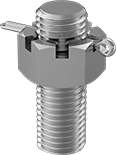Filter by
Thread Size
System of Measurement
Locking Type
Fastener Strength Grade/Class
Thread Type
Hex Nut Profile
Specifications Met
Thread Fit
Performance
Material
DFARS Specialty Metals
Export Control Classification Number (ECCN)
Sold As
Thread Direction
Drive Style
Insert Maximum Temperature
Distorted Thread Type
Nylon-Insert Locknuts
Versatile yet economical, these are the most commonly used locknuts. The nylon insert grips the screw to prevent loosening from moderate vibration without damaging threads. However, the insert may become brittle if exposed to high temperatures. These locknuts are reusable a handful of times, but the holding power decreases with each use.
High-Strength Steel
 |
Rated Grade 8, Grade C, or Class 10, these locknuts are about 25% stronger than medium-strength steel nuts. To avoid stripped threads during installation, make sure your screw has a comparable strength rating.
Zinc-Plated Steel—A step up from plain steel, the zinc plating withstands occasional exposure to moisture.
Medium-Strength Steel
 |
These Grade 5 or Class 8 nuts are your go-to for fastening most machinery and equipment. To avoid stripped threads during installation, make sure your screw has a comparable strength rating.
Zinc-Plated Steel—A step up from plain steel, the zinc plating withstands occasional exposure to moisture.
Locknuts for use with Cotter Pins
Use these locknuts to secure rotating parts subjected to mild vibration, such as the wheels on carts and hand trucks. They’re not recommended for use on parts exposed to high vibration because the pin can shear under prolonged stress. These nuts are reusable, but you'll need a new cotter pin (not included) with each use.
Medium-Strength Steel
 |  |
These Grade 5 or Class 8 nuts are your go-to for fastening most machinery and equipment. To avoid stripped threads during installation, make sure your screw has a comparable strength rating.
Steel—Best for dry environments since moisture will cause these nuts to rust.
Top-Lock Distorted-Thread Locknuts
Irregularly shaped threads at the top of these locknuts grip the screw for a stronger hold than nylon-insert locknuts. Although the threads prevent the nut from backing out due to vibration, they also increase the effort to install and remove. To get these nuts off, you may need special tools, such as an impact wrench or propane torch. Nuts are not reusable.
Medium-Strength Steel
 |
These Grade 5 or Class 8 nuts are your go-to for fastening most machinery and equipment. To avoid stripped threads during installation, make sure your screw has a comparable strength rating.
Zinc-Yellow-Chromate-Plated Steel—With a more durable finish than clear zinc plating, these nuts are suitable for most wet and outdoor environments. However, they won't hold up to the harsh chemicals that stainless steel can.
Thread Size | Wd., mm | Ht., mm | Fastener Strength Grade/Class | Specs. Met | Pkg. Qty. | Pkg. | |||||||||||||||||||||||||||||||||||||||||||||||||||||||||||||||||||||||||||||||||||||||||||||
|---|---|---|---|---|---|---|---|---|---|---|---|---|---|---|---|---|---|---|---|---|---|---|---|---|---|---|---|---|---|---|---|---|---|---|---|---|---|---|---|---|---|---|---|---|---|---|---|---|---|---|---|---|---|---|---|---|---|---|---|---|---|---|---|---|---|---|---|---|---|---|---|---|---|---|---|---|---|---|---|---|---|---|---|---|---|---|---|---|---|---|---|---|---|---|---|---|---|---|---|
Zinc-Yellow-Chromate-Plated Steel | |||||||||||||||||||||||||||||||||||||||||||||||||||||||||||||||||||||||||||||||||||||||||||||||||||
| M36 × 4 mm | 55 | 36 | ISO Class 8 | DIN 980V | 1 | 93795A321 | 00000 | ||||||||||||||||||||||||||||||||||||||||||||||||||||||||||||||||||||||||||||||||||||||||||||





























